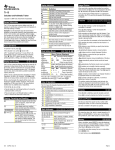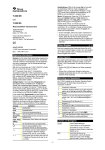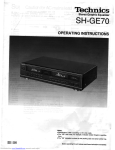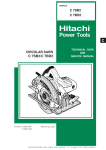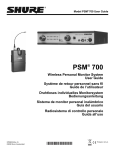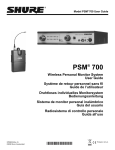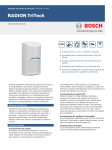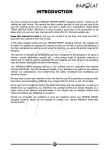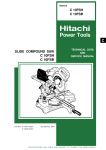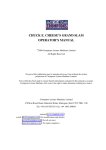Download Texas Instruments TI-10 Calculator User Manual
Transcript
Display Indicators TI-10 Fix Calculator and Arithmetic Trainer Op1 Copyright 2001, 2002 Texas Instruments Incorporated Auto General Information .P The TI-10 has two power sources — battery and solar. It operates in well-lit areas using the solar cell, and it operates in other light settings using the battery. Examples: See the “Examples” page for problems with keystroke sequences that demonstrate many of TI-10 functions and capabilities. Before starting each problem set, reset and clear the TI-10 by pressing b”. This helps to ensure that your displays are the same as those shown in the examples. In Problem Solving AUTO mode, however, displays will vary from those shown in the examples because the problems presented by the TI-10 are random. y z Indicator Definition Press Ù (Division result format) QR +1 ? (Show or hide OP) n(Clear stored operation) Y n Y(Reject or select RESET) Press Problem Solving Tool (AUTO) ‡ ‡ $ ‡ $$ AUTO MAN(Automatic or Manual) 1 2 3 (Level of Difficulty) + - Q P ?(Type of Operation) Press Problem Solving Tool (MAN) AUTO ‡"® ‡"®$ 11 -. MAN (Automatic or Manual) - 1 -. (Place Value feature) Once in a menu: The TI-10 has a two-line display that shows up to 11 characters at a time on each line. Entries that do not fit on the first line wrap to the second. When the second line is filled, the characters scroll up. Entries can be up to 88 characters. Exceptions: For Op1 (Stored Operation), the limit is 44 characters. For ‹ (Problem Solving) MAN (manual) mode, entries do not wrap; entries cannot exceed 11 characters. When a result exceeds the capacity of the display, it is shown in scientific notation. However, if the result is greater than 1099, an OVERFLOW ERROR is displayed; if the result is less than 10L99, an UNDERFLOW ERROR is displayed. Scroll using these keys: ", !, # , and $ . ¦ Press " and ! to scroll through entries or to move the ¦ To underline a menu item, press ! or" . ¦ To select the underlined item, press ® . ¦ To exit a menu, press ‡ . Note: To select an option from the Place Value menu, the TI-10 must be in ‹ (Problem Solving) MAN (manual) mode. Pressing ‡ while in the ‹ (Problem Solving) tool temporarily displays the Scoreboard before the AUTO / MAN menu is displayed. Order of Operations The TI-10 uses the Equation Operating System (EOSé) to evaluate expressions. underline from one item to another within a menu. ¦ Press # and $ to scroll through history or to move between menus when the menus are displayed. b Calculator Tool ‡ ‡$ ‡ $$ ‡ $$$ "! # $ Clearing, Correcting, and Resetting x Calculator / Problem Solving Menus − Two-Line Display and Scrolling | | TI-10 is in the Place Value feature. TI-10 is rounding results. A value other than zero is in memory. Stored operation is active. Problem Solving (‹) is in AUTO (automatic) mode. When using W, result will be displayed in decimal format. More entry history or menus are available. Press # (up) or $ (down) to access. An entry extends beyond the capacity of the display. Press!or"to scroll. w To turn the TI-10 on, press − . If the TI-10 is on, press − to turn it off. If you do not press any keys for about five minutes, the Automatic Power Down™ (APD™) feature turns off the TI-10 automatically. After APD, press − to power up again. The display, all pending operations, settings, and memory (including history) are retained. ” TI-10 is in the Problem Solving tool. ƒ M On/Off w ‹ 1st Expressions inside parentheses. 2nd Functions that require a closing parenthesis ) and precede the argument. 3rd Negation (N). 4th Multiplication, implied multiplication, division. 5th Addition and subtraction. 6th Z completes all operations. ”w Deletes the character to the left of the cursor. Only clears the display and error condition. Does not clear value from memory, mode settings, etc. Clears the value from memory. Basic Arithmetic q, k, o, T, r M Resets the TI-10 clearing the calculator completely and restoring all default settings. MEM CLEARED is displayed. Press ” to clear the display. You can also reset by: ¦ Using the RESET menu. See Calculator/Problem Solving menus. ¦ Pressing − and ” simultaneously. h, i, j, l, m, n, p U, V, W X, Y Z -1- TUVWrMXYZ Enters the numerals 0 through 9. Adds, subtracts, multiplies, divides. Inserts a decimal point. Enters a negative sign. (Does not act as an operator.) Opens, closes a parenthetical expression. Completes all operations. W Division Problem Solving When you divide a positive whole number by a positive whole number using W, the result is displayed in the form Q r R, where Q is the quotient and R is the remainder. For example, if you are in the QR setting: 12 ÷ 5 = 2 r 2. If you use the result of QR division in a subsequent calculation, the TI-10 uses only the quotient. The remainder is dropped. For decimal results, select the decimal division setting by pressing ‡" ® . Press ‡ ® to see the previous answer as a decimal. For example: 12 ÷ 5 = 2.4. `a| Memory After a calculation, press ` to add the displayed result to the value in memory or a to subtract the displayed result from the value in memory. Whenever memory contains a value other than 0, M displays on the screen. To recall the value from memory for use in a calculation, press | once. To clear memory, press | twice. › Stored Operation Op1 stores an operation with a constant value. You can then repeat this stored operation as many times as desired by pressing a single key — ›. 1. Press › . Procedure. When a problem is presented: 1. Enter an answer and press ®. 2. If your answer is correct, the display shows YES, clears the screen, and presents another problem. 3. If your answer is not correct, the display shows no and indicates whether the correct solution is less than < or greater than > the answer that you entered. 4. The incorrect answer is cleared from the display so you can enter another answer to that same problem. 5. If you enter three incorrect answers to a given problem, the TI-10 shows the correct answer, clears that problem, and presents a new problem. 2. Enter the operator first (+, -, Q, P) and then the number. 3. Press › . 4. Initialize with a starting value. 5. Each time you press › , the operation with the constant is applied. The computation with the stored operation appears in the first line of the display, and the result appears in the second line. To hide the computation line: 1. Press ‡ $ " (to underline ?, if necessary) ® . 2. Press ‡ again to return to the stored operation. 3. Continue pressing › . If the expression does not fit on the line, it will not show. When display space permits, a counter on the second line shows how many times you have pressed ›. To clear the contents of Op1: 1. Press ‡ $$ . Scoreboard. The TI-10 shows a Scoreboard after every fifth problem. Every correct solution you entered registers one YES in the Scoreboard, and three incorrect answers in a row register one no in the Scoreboard. After 100, the Scoreboard returns to zero. Press ‡ to display the Scoreboard at any time. The Scoreboard is then replaced by the AUTO / MAN menu after a few seconds. Press ‡ again to return to the problem. MAN Mode Using ‹ (Problem Solving) MAN (manual) mode, you can compose your own problems. 1. Press ‡ to access the menu. 2. Press " to underline MAN. 3. Press ® ‡. The TI-10 is ready for you to enter your problem and your solution. The TI-10 accepts only non-negative integers in this mode. To indicate a missing element, press . In ‹ (Problem Solving), press ] to change between AUTO and MAN mode. Auto shows in the top line of the display when Problem Solving AUTO is selected. In ‹ MAN mode, it is possible to enter a problem that has one solution, multiple solutions, or no solution. The TI-10 tells you how many solutions the problem has. 2. Select Y (yes), if necessary. 3. Press ® . 4. Press ” or ‡ to return to the last result display. Resetting the TI-10 also clears Op1. Š‘’“˜™ Rounding You can round results using Š in conjunction with the Place Value keys to specify a given number of places. The internally stored value is not rounded. The calculated value is padded with zeros as needed. You must press Š each time you want to change the number of places. Keys Š Š ‘ Š ’ Š “ Š ˜ Š ™ Š r ‹[\ Problem Solving lets you practice and test your skills. To enter Problem Solving, press . You can choose either AUTO (automatic) or MAN (manual) mode. AUTO Mode In ‹ (Problem Solving) AUTO mode (the default), the TI-10 presents problems with one element missing, for example: 5+2=? or 5+?=7 or 5?2=7. You can select the type of problem and choose from three levels of difficulty. The default is addition at Level 1. Level of Difficulty. While in ‹ AUTO mode, press ‡ $ to access the menu. Press " or ! to select the level of difficulty (1, 2, or 3). Press ® ‡, and the TI-10 will present problems at the selected level. Or, while in ‹mode, press c to advance to the next level. After Level 3, pressing c again returns you to Level 1. Type of Problem. While in ‹ AUTO mode, press ‡ $$ to access the menu. Press " or ! to select the type of problem — addition (+), subtraction (N), multiplication (x), division (P), or find the operator (?). Press ® ‡, and the TI-10 will present problems of the selected type. Action Rounds to thousands. Rounds to hundreds. Rounds to tens. Rounds to ones. Rounds to nearest tenth. Rounds to nearest hundredth. Removes fixed-decimal setting. ¦ Problems with one missing element generally have only one solution. You get three tries. After three incorrect answers, the calculator displays the correct answer and then clears the display so you can enter a new problem. ¦ Problems with two missing elements may have multiple solutions. For example: ?+?=5 has 6 solutions; ?x?=24 has 8 solutions. For multiple-solution problems, the question mark replaces the operands. Question marks may not appear in the place of the operator or the answer. These problems are not cleared after a correct solution or after three incorrect answers. Instead, the problem remains so that you can enter other solution sets. To clear the problem at any time, press ”. ¦ When the answer to a problem is not a positive integer (such as 9P2), the TI-10 indicates that the problem has zero solutions. These Place Value keys also work with Œ. See Place Value. -2- However, if you enter an answer, it will tell you whether your answer is less than < or greater than > the correct answer. 2. Remove the screws from the back of the case, using a small Phillips screwdriver. Inequalities. Instead of entering an equation, you can test an inequality using [ or \. You get only one try because the inequality statement is either true or false. With inequalities you can enter decimals. To exit Problem Solving, press again. All Problem Solving history will be cleared. Place Value 3. Carefully separate the front from the back, starting from the bottom of the case. Caution: Be careful not to damage any internal parts. 4. Remove the old battery, using a small Phillips screwdriver, if necessary. 5. Replace with a new battery, and then replace the back of the case. Œ‘’“˜™ Caution: Avoid contact with other TI-10 components while changing the battery. In ‹ (Problem Solving) MAN mode, you can access the Place Value menu by pressing ‡ $ . 6. If necessary, reset the TI-10. See Clearing, Correcting, and Resetting. ¦ What is the place value of a given digit? Enter a number. To determine the whole number place or the decimal place of a given digit, press Œ and then press the digit in question. For a number with a repeated digit, press the given digit once for the first occurrence, twice for the second occurrence, etc. Each time you press the given digit in succession, the display shifts to the next occurrence of the digit to the left of the first occurrence and shows the place value for that occurrence. ¦ How many ones, tens, hundreds, thousands, tenths, or hundredths are in a given number? Press ‡ $, if necessary underline 11 -. (default), and press ® ‡ . Enter the number to be analyzed, press Œ , and then press “, ’ , ‘ , , ˜ , or ™ . Caution: Dispose of old batteries properly. Do not incinerate batteries or leave where a child can find them. TI Product Service and Warranty Information For General Information ¦ What digit of a number is in a given place? Press ‡ $, underline - 1 -., and press ® ‡ . Enter the number to be analyzed, press Œ , and then press “, ’ , ‘ , , ˜ , or ™ . The answer appears briefly and then clears so you can press another digit or Place Value key. [email protected] Phone: 1.800.TI.CARES (1.800.842.2737) For U.S., Canada, Mexico, Puerto Rico, and Virgin Islands only Home Page: education.ti.com For Technical Questions Phone: 1.972.917.8324 For Product (hardware) Service Customers in the U.S., Canada, Mexico, Puerto Rico and Virgin Islands: Always contact Texas Instruments Customer Support before returning a product for service. All other customers: Refer to the leaflet enclosed with this product (hardware) or contact your local Texas Instruments retailer/distributor. Once Place Value is active, it is not necessary to press Œ before each digit or place that you wish to examine for a given number. You must press ” before entering a new number to analyze. Then you must activate Place Value again by pressing Œ. To exit Place Value, press ”. 1-Year Limited Warranty Error Conditions Arith Error Syn Error P 0 Error Mem Error Op Error E-mail: Customers in the U.S. and Canada Only—One-Year Limited Warranty for Commercial Electronic Product Arithmetical error. Syntax error. Attempting to divide by zero. Error in attempting to store entry in memory. Error following steps for using Op1. Overflow. Result is too large for the display. This Texas Instruments (“TI”) electronic product warranty extends only to the original purchaser and user of the product. Warranty Duration. This TI electronic product is warranted to the original purchaser for a period of one (1) year from the original purchase date. Warranty Coverage. This TI electronic product is warranted against defective materials and construction. THIS WARRANTY IS VOID IF THE PRODUCT HAS BEEN DAMAGED BY ACCIDENT OR UNREASONABLE USE, NEGLECT, IMPROPER SERVICE, OR OTHER CAUSES NOT ARISING OUT OF DEFECTS IN MATERIALS OR CONSTRUCTION. Warranty Disclaimers. ANY IMPLIED WARRANTIES ARISING OUT OF THIS SALE, INCLUDING BUT NOT LIMITED TO THE IMPLIED WARRANTIES OF MERCHANTABILITY AND FITNESS FOR A PARTICULAR PURPOSE, ARE LIMITED IN DURATION TO THE ABOVE ONE-YEAR PERIOD. TEXAS INSTRUMENTS SHALL NOT BE LIABLE FOR LOSS OF USE OF THE PRODUCT OR OTHER INCIDENTAL OR CONSEQUENTIAL COSTS, EXPENSES, OR DAMAGES INCURRED BY THE CONSUMER OR ANY OTHER USER. Some states/provinces do not allow the exclusion or limitation of implied warranties or consequential damages, so the above limitations or exclusions may not apply to you. Legal Remedies. This warranty gives you specific legal rights, and you may also have other rights that vary from state to state or province to province. Warranty Performance. During the above one (1) year warranty period, your defective product will be either repaired or replaced with a reconditioned model of an equivalent quality (at TI’s option) when the product is returned, postage prepaid, to Texas Instruments Service Facility. The warranty of the repaired or replacement unit will continue for the warranty of the original unit or six (6) months, whichever is longer. Other than the postage requirement, no charge will be made for such repair and/or replacement. TI strongly recommends that you insure the product for value prior to mailing. Software. Software is licensed, not sold. TI and its licensors do not warrant that the software will be free from errors or meet your specific requirements. All software is provided “AS IS.” Copyright. The software and any documentation supplied with this product are protected by copyright. Overflow Error Underflow Underflow. Result is too small for the display. Error In some cases, ” restores the last display before the error message appeared. Errors appear in history as Error. In Case of Difficulty If you get unexpected results: ¦ Review the instructions to be certain calculations were entered correctly. ¦ Check the mode (‡ ) setting and rounding (Œ ) function. ¦ Reset the TI-10. See Clearing, Correcting, and Resetting. ¦ Check the battery to ensure that it is fresh and properly installed. See Battery Replacement. Change the battery when: − − does not turn the unit on, or − the screen goes blank, or − you get unexpected results. To continue using the TI-10 until you can change the battery: 1. Expose the solar panel to brighter light. 2. Reset the TI-10. See Clearing, Correcting, and Resetting. All Customers outside the U.S. and Canada Battery Replacement For information about the length and terms of the warranty, refer to your package and/or to the warranty statement enclosed with this product, or contact your local Texas Instruments retailer/distributor. The TI-10 uses the CR2025 battery, or the equivalent. 1. Place the protective cover over the TI-10, and then turn the calculator face down. -3- − T U V W Z ! " − − #$ b” T 2T3Z U 7U4Z V 2V4Z W 6W3Z # ### $ $ !" T ## !!!4""2Z ” w (continued) 6T21 3 w 3 2+3= 5 7N4= 3 2Q4= 8 wZ 7T3!!w6Z 6U5wwT4Z 8 6+3= 9 6+4= 10 3 2r0 W 2+3= 7N4= 5 3 7N4= 2Q4= 74N42= 6+2= W ‡ b” 6P3= 6+21 9W4Z 9P4 2 r 1 ‡"® ÙP QR 3 8 P ” 32 9P4= ÙP 2r 1 9P4= ÙP 2.25 9W4Z b” Ùê 3 r ‡ T 1T1Z 1T2Z 1T3Z 1T4Z 1+1= 2 1+2= 3 1+3= 4 1+4= 5 b” r 6r3T2r4Z 4r2V3r1Z ‡" ® 3 6 . 3 + 2 . 4 = 8.7 4.2Q3.1= 13.02 ÙP QR Ùê P # ### $ $ $ 1+1= 1+2= 2 3 1+2= 1+3= 3 4 1+3= 1+4= 4 5 96r3W2r52Z M b” M ”w b” 6T33 ” ” 6T1Z 5TM2Z 5UM2Z 3 4VM2Z 6+33 3 6+1= ÙP 96.3P2.52= 38.21428571 7 -4- 3 5+ -2= 3 5N -2= 7 4Q -2= -8 Š ˜ ™ “ ’ ‘ (continued) X Y b” 3V4T2Z XY 3VX4T2YZQ Š Š Fix Š‘ Š ‘ Fix Š’ Š ’ Fix Š“ Š “ Fix Š˜ Š ˜ Fix Š™ Š ™ Fix Šr Š r 4000. 3 3Q4+2= 3Q(4+2)= 4100. 14 4130. 18 4128. ` a b” 4T2Z ` ` 1T1Z a a | | 3 4+2= 6 M 1+1= b” 2 ‹ ||” ‹ 11® ‹ Auto 8+3=? 3 Auto 8+3=11 M 4+1= YES 5 ‹ Auto 3+?=8 3 3 5® ‹ Auto 3+5=8 YES › b” › 3 ‹ M 43 T1Z 4128.412508 ‹ 2 M 1+1= 4128.41 6 M 4+2= 4128.4 ›T1› 1› › › › ### $ ‹ 9+7=? 3 3 Op1 15® ‹ 18® ‹ 17® ‹ +1 Auto 9+7>15 NO Op1 1+1 1 Op1 2+1 2 YES ‹ Op1 Auto 4+?=6 3 5 2® Op1 2 3 ‹ Auto 4+2=6 YES ‹ Op1 2+1= 3+1= Auto 9+7=16 4 1+1= 2+1= Auto 9+7<17 ‹ Op1 4+1 4 9+7<18 NO 3 3+1 3 Auto NO 2 Auto 8+?=13 3 3 4 5® Š ˜ ™ “’ ‘ b” Auto ‹ Auto 8+5=13 YES ‹ 3 Auto YES 4 42r394V97r3 4128.412508 82Z -5- NO 1 ‹ ‡ b” 1 2 3 ‹‡$"® ‡ 406® ‹ ‡ Œ ™ ˜ “’ ‘ b” 3 ‹ Auto ‹‡ 1 2 3 ê ë ì ‹ Auto 6+400=? 3 ‹ Auto Œ 6+400=406 YES 3 ‹‡"® ‹ ‡ ‹ 4379r65Œ ‹ƒ AUTO 3 4379.65 3 + N Q P ? ‡$$"" ® ‹ Auto ‡ ‹ Auto ‹ƒ 10Q40=? 3 4379.65 3"100 400® ‹ Auto 3 + N Q P ? 5 10Q40=400 YES ‹ Auto 70N40>20 ‡‹ ‹‡"® ‹ Auto 70N40=30 YES ‡ 3 ‹ AUTO MAN ‹ 3 14UZ10® ‹ 4® ‹ VZ24® ‹ 8®3® ‹ 14N?=10 1 SOL 14N4=10 ?Q?=24 8 SOL ‹ ‹ƒ ™ ‹ƒ ‡$"® ‹ƒ ‡ ‹ƒ ’ ‹ƒ ˜ ‹ƒ YES Texas Instruments 7800 Banner Dr. Dallas, TX 75251 U.S.A. education.ti.com ‹ ?Q?=24 3 7V6[43® ‹ 3 ¾ 7Q6<43 Texas Instruments Holland B.V. Rutherfordweg 102 3542 CG Utrecht - The Netherlands YES 15W3\4® 7653.49 3 7653.49 7êêê.êê 7653.49 765349 11 -. - 1 -. ƒ 7653.49 3 7653.49 êê5ê.êê 7653.49 êêêê.4ê Copyright 2001, 2002 Texas Instruments Incorporated 8Q3=24 ‹ 4379.65 êêêê.ê5 YES ” ‹ƒ ”7 6 5 3 r 4 9 Œ ‹ ‡ [ \ b” 4379.65 ê3êê.êê 4379.65 5"0.01 NO 30® ‹ƒ ‹ƒ ‡ $ $ ! ® ‹ Auto 70N40=? ‡ 3 20® MAN ‹ 15P3>4 YES -6-






